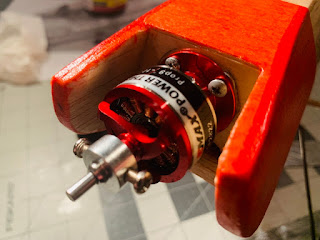Covering test
I decided to stay with the old-school theme and cover the Chicken Hawk with silk span. The last time I used silk span was probably around 35 years ago on a glider I built. The process I remember involved attaching the dry silk span sheet to the wing surface with lacquer thinner, then wetting the sheet to get it to stretch, and finally applying a couple of Sanding Sealer coats to the covered wing. We used Sanding Sealer instead of Dope, probably because of price and availability.
And after two more coats of Sealer and twelve hours of drying time.
The overall process I used is as follows:
After searching the web and checking with my fellow club members, I found that the recommended process is not much different today then it was a few decades ago. I started with a test frame in order to get some practice and make sure I have the right materials.
In general, the recommended process involves applying a few coats of Dope on the balsa surface you want to cover, then attaching and stretching a sheet of silk span. The sheet is fixed into place with some more Dope or thinner. There are many variations to this process. Some attach a dry sheet of silk span and wet it after it is attached, others use a wet sheet which makes it easier to stretch and fix into place. Some use Dope, others glue. Some use water-based others not. You get the picture.
The materials I am using are water-based Sanding Sealer by Minwax. No obnoxious odors, easy to clean, and just as effective. All I need is a protective coat over the wing covering and fuselage, with no need for it to be fuel resistant.
I made a small 4"x6" balsa frame to cover with silk span and used a balsa scarp piece to test the covering capability of the Sanding Sealer i chose.
The balsa piece after three coats of Sealer and 400 grit sanding in between yielded a smooth, water resistant, sheet with a nice sheen. There was no warping, but I will follow the advice of coating both sides of a sheet at once, with areas such as the stabilizer, to make sure warps don't appear unexpectedly.
The covering was equally satisfactory. I coated the frame with three layers of Sealer and 400 grit sanding in between. I then stretched a wet sheet of silk span over the frame, and attached it using a small brush dipped in Sealer material that I brushed along the balsa edges.
- Fine sanding of all surfaces with 280 to 400 grit and remove all dust.
- Apply a Sanding Sealer coating.
- Let dry for minimum of 4 hours.
- If applying another coat first sand with 400 grit.
- Repeat (2) (3) and (4) three times for exposed balsa areas like fuselage, twice for edges of wings to be covered with silk span. Could be more coats depending on personal preference. I did not check weight differences, but this would be a factor to consider.
- Place a wet silk span sheet on the frame to cover and gently stretch to remove all wrinkles. I used a spray bottle with some tap water. The wet sheet will cling to the Sealer-coated balsa frame.
- Apply Sanding Sealer to the balsa edges through the wet silk span sheet. carefully keep stretching to remove new wrinkles, but make sure you don't detach or damage the silk span.
- Allow to dry for an hour and remove extra silk span from edger with a sharp blade, or sand the edge to cut the silk span off.
- Hold the frame down while drying to prevent warping(?)
- Apply a Sanding Sealer coat.
- Let dry for minimum of 4 hours.
- If applying another coat then very gently sand the silk span surface with 400 grit.
- Repeat (10) (11) and (12) twice (or more depending on preference).









Comments
Post a Comment